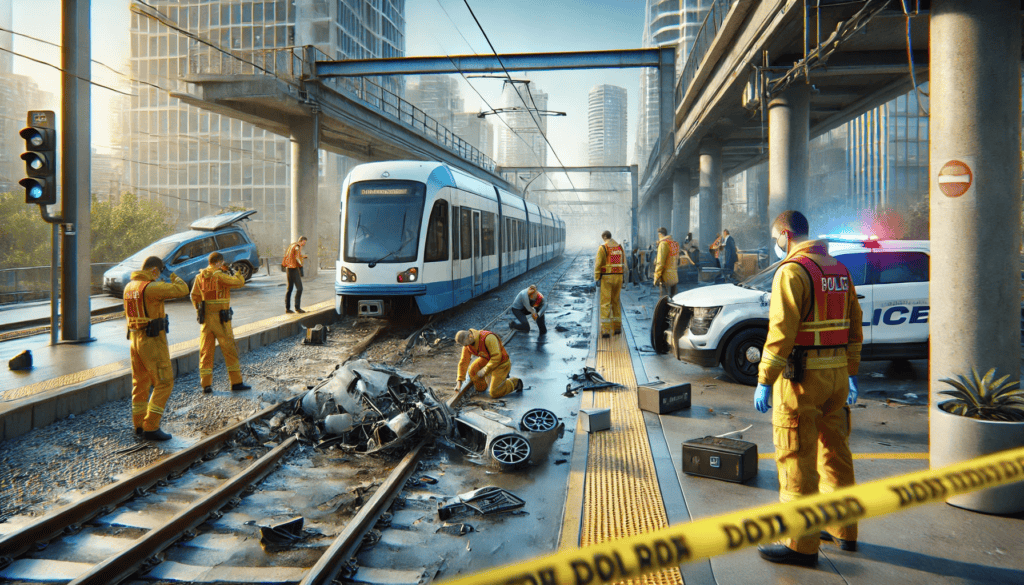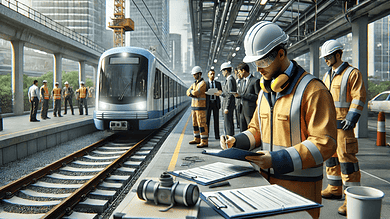Light Rail Accident Investigation: The Expert’s Approach

Effective Light Rail Accident Investigation
Light rail systems are integral to urban transportation, offering an efficient and environmentally friendly way to move many people.
As cities expand and populations grow, the importance of these systems continues to increase. However, with their growth comes the inevitable risk of accidents, which can have severe consequences for passengers, operators, and the public.
Effective light rail accident investigation is crucial for understanding the causes of these incidents and preventing future occurrences.
Accident investigations in light rail systems are complex and require a systematic approach. They involve various steps, tools, and techniques for gathering and analyzing evidence.
The role of expert witnesses, such as rail accident reconstruction experts and public transportation safety consultants, is critical in providing credible and unbiased analyses.
This article explores the steps involved in light rail accident investigations, the tools and techniques used, and the importance of expert witnesses in ensuring thorough and accurate investigations.
Steps in Accident Investigation
Initial Response
The first step in a light rail accident investigation is the initial response. This involves securing the accident scene to prevent further damage and ensure the safety of responders and the public.
Emergency services are typically the first on the scene, followed by investigators who begin their work once the area is secured. This phase is crucial to ensure evidence is not tampered with and the site remains safe for investigation.
Documentation and Evidence Collection
Once the scene is secure, investigators begin documenting and collecting evidence. This includes taking photographs and videos of the scene, recording the positions of vehicles and debris, and collecting witness statements.
Documentation is crucial as it provides a detailed record of the accident scene, which is essential for later analysis.
Physical evidence, such as tracks, vehicles, and signaling equipment, is carefully examined during an accident investigation.
If the accident involves a derailment, the point of departure, where the wheel leaves the rail, is marked and measured. Investigators look for signs of mechanical failure, wear and tear, and other factors that may have contributed to the accident.
This detailed examination helps us understand the events leading to the incident. Witness statements are also critical as they provide first-hand accounts of the accident, which can be invaluable in putting the events together.
Analysis of Physical Evidence
The analysis of physical evidence is a critical step in accident investigations. Experts inspect the tracks for any irregularities, such as misalignments or damage, that could have caused the accident.
The condition of the vehicles involved, including the braking systems, wheels, and other mechanical components, is also assessed.
Rail accident reconstruction experts play a vital role in this phase. They use the collected evidence to recreate the accident scenario, helping to identify the exact cause of the incident.
By analyzing the physical evidence, they can determine whether the accident was due to human error, mechanical failure, a combination of both, or other factors. This reconstruction is vital for providing a clear and accurate understanding of the incident.
Role of a Rail Accident Reconstruction Expert
A rail accident reconstruction expert uses advanced tools and techniques to recreate the accident scenario.
Often, they employ simulation software and 3D modeling to visualize the accident, allowing for a detailed analysis of the events leading up to the incident. This reconstruction is crucial for understanding the dynamics of the accident and identifying the root cause.
These experts compile their findings into a comprehensive report used by transit authorities, regulatory bodies, and legal teams. The report provides a detailed account of the accident, including the identified causes and recommended measures to prevent future occurrences.
The expert’s testimony can also be crucial in court cases, providing a clear and unbiased explanation of the accident.
Compilation of Findings and Final Report
The final step in the accident investigation process is compiling findings and preparing the final report. This report includes all the collected evidence, analyses, and conclusions the investigators drew.
It serves as an official record of the investigation and provides recommendations for improving safety measures and preventing similar accidents in the future.

3. Tools and Techniques Used
Advanced Tools and Technologies
Detailed light rail accident investigation relies heavily on advanced tools and technologies. These tools enable investigators to gather detailed evidence and perform comprehensive analyses.
One of the primary tools used is simulation software, which helps recreate accident scenarios and analyze the dynamics involved.
Simulation Software and 3D Modeling
Simulation software and 3D modeling are essential in accident reconstruction. These tools allow investigators to create a virtual model of the accident scene, visually representing the events.
They can simulate the accident and identify the contributing factors by inputting data such as vehicle speeds, track conditions, and environmental factors.
These highly detailed simulations can show the sequence of events from multiple perspectives. This helps investigators understand the dynamics of the accident, including how different factors interacted to cause the incident.
Onboard Event Recorders and CCTV Footage
Data from onboard event recorders and CCTV footage is invaluable in accident investigations. Event recorders, often called “black boxes,” capture crucial data such as vehicle speed, braking, and operator actions leading up to the accident.
CCTV footage provides visual evidence of the incident, helping investigators understand the sequence of events.
The analysis of this data can reveal critical information about the vehicle’s state and the operator’s actions in the moments leading up to the accident. This information is crucial for determining the accident’s cause and identifying potential human errors.
Human Factors and Operator Performance
Analyzing human factors and operator performance is another critical aspect of accident investigations. Investigators assess the operators’ actions and decisions, considering factors such as fatigue, stress, and training. This analysis helps determine whether human error played a role in the accident.
Understanding human factors is crucial for developing effective safety protocols. By identifying the root causes of human error, investigators can recommend changes to training programs, operational procedures, and safety measures to prevent future accidents.
Forensic Engineering Methods
Forensic engineering methods are applied to analyze the physical components of the light rail system. This includes examining the materials used in tracks and vehicles, assessing the impact forces during the accident, and identifying any signs of failure or wear.
These methods provide a scientific basis for understanding the causes of the accident and developing preventive measures.
Forensic engineers use various techniques to examine the physical evidence, including microscopic analysis, material testing, and computer simulations. These techniques help identify any weaknesses or failures in the light rail system’s physical components that may have contributed to the accident.

4. Importance of Expert Witnesses in Investigations
Role of Expert Witnesses
Expert witnesses are crucial in providing credible and unbiased analysis during accident investigations. Their specialized knowledge and experience are invaluable in understanding complex technical details and presenting them clearly and understandably.
Expert witnesses are often called upon to provide testimony in court cases, offering their expert opinions on the causes of the accident and the effectiveness of the safety measures in place. Their testimony can be crucial in determining liability and ensuring justice.
Public Transportation Safety Consultants
A public transportation safety consultant supports legal proceedings by providing expert testimony and detailed reports. These consultants help ensure that investigations are thorough and accurate, offering insights that can influence the outcome of legal cases. Their involvement is critical in establishing the facts and ensuring justice.
Safety consultants deeply understand the regulations and standards governing public transportation systems. They use this knowledge to assess whether the safety protocols in place were adequate and whether any violations occurred that may have contributed to the accident.
Case Studies Highlighting Expert Witness Impact
These case studies serve as theoretical examples to demonstrate potential scenarios and outcomes. While they draw on elements that could be seen in real cases, they remain entirely speculative and are used purely for educational and illustrative purposes.
Case studies highlight the impact of expert witness testimony in light rail accident investigations. For example, in a high-profile accident involving a derailment, the testimony of a rail accident reconstruction expert was instrumental in identifying the cause of the accident and recommending safety improvements.
In another case, a public transportation safety consultant provided crucial evidence in court, demonstrating that the accident was due to inadequate maintenance and training. Their testimony helped secure a favorable outcome for the victims and significantly changed the operator’s safety protocols.
These case studies demonstrate the vital role that expert witnesses play in accident investigations. Their expertise and testimony can help to identify the root causes of accidents, ensure that responsible parties are held accountable, and drive improvements in safety measures to prevent future incidents.
Ensuring Accuracy and Reliability
The involvement of expert witnesses ensures that accident investigations are conducted with the highest accuracy and reliability. Their expertise in accident analysis in light rail and understanding of light rail safety protocols contribute to a comprehensive investigation process that leaves no stone unturned.
Expert witnesses bring rigor and credibility to the investigation process. Their detailed analyses and clear explanations help ensure that the investigation’s findings are accurate and reliable, providing a solid basis for any legal proceedings or safety improvements that may follow.
Detailed Case Studies
These case studies draw on elements that are seen in real cases, but they remain entirely speculative and are used for educational and illustrative purposes.
Case Study 1: Metro City’s Safety Overhaul
In Metro City, a significant light rail accident resulted in multiple injuries and public concern. The city’s transit authority enlisted the help of a rail accident reconstruction expert to conduct a comprehensive investigation. The expert used advanced simulation software to recreate the accident, revealing that faulty signaling and human error were to blame.
The final report recommended several safety upgrades, including updated signaling systems and enhanced operator training programs. These measures improved the system’s safety record and restored public confidence.
Case Study 2: Urbanville’s Compliance Strategy
Urbanville faced compliance issues with new federal safety regulations, which posed a risk to its light rail operations. The city’s transit authority brought a public transportation safety consultant to develop a compliance strategy. The consultant conducted a detailed audit, identifying gaps in the current safety protocols.
Recommendations included rigorous maintenance schedules, comprehensive staff training programs, and regular safety drills. These changes ensured Urbanville’s compliance with federal regulations and significantly reduced the incidence of safety violations.
Case Study 3: Safety Improvements in Railtown
Railtown experienced a serious accident due to an infrastructure failure, highlighting the need for better safety measures. A public transportation safety consultant was hired to investigate the incident. The consultant’s analysis revealed that the track maintenance protocols were outdated and insufficient.
The recommendations included adopting a predictive maintenance schedule using advanced monitoring technologies. These changes resulted in fewer accidents and improved the light rail system’s overall reliability.
Case Study 4: Compliance in Cityville
Cityville’s light rail system was under scrutiny for not meeting safety standards. A light rail safety expert was brought in to assess the situation. The expert’s investigation identified several areas of non-compliance, including outdated equipment and insufficient operator training.
By following the expert’s recommendations, which included upgrading equipment and enhancing training programs, Cityville achieved full compliance with safety regulations and significantly improved its safety record.
Case Study 5: Modernizing Safety Protocols in Tech City
Tech City aimed to modernize its light rail system with the latest technology. A light rail safety expert was engaged to ensure that new technological implementations would not compromise safety. The expert extensively reviewed proposed technologies, such as automated train control systems and real-time monitoring tools, to assess their impact on safety protocols.
The expert’s analysis revealed that while these technologies had the potential to enhance operational efficiency, they required robust safety protocols to manage new risks. Recommendations included integrating advanced monitoring systems to detect anomalies in real-time, updating training programs for operators to handle new technology, and comprehensive emergency response strategies that included technological failures.
Implementing these recommendations allowed Tech City to modernize its light rail system while maintaining high safety standards.
Case Study 6: Enhancing Emergency Response in Coastal City
Coastal City, prone to natural disasters, needed to enhance its emergency response capabilities for its light rail system. A public transportation safety consultant was hired to develop a comprehensive emergency preparedness plan. The consultant worked with local authorities to assess the risks posed by potential natural disasters, such as hurricanes and floods, and their impact on the light rail system.
The consultant’s plan included establishing emergency communication protocols, strategically placing emergency equipment, and conducting regular emergency drills involving operators and first responders. The plan also emphasized the importance of maintaining clear and accessible evacuation routes and providing real-time information to passengers during emergencies.
Coastal City’s adoption of these measures significantly improved its ability to respond to emergencies, ensuring the safety of passengers and operators during natural disasters.

Accident Analysis in Light Rail
Effective light rail accident investigation is crucial for understanding the causes of incidents and preventing future occurrences. By following a systematic approach, investigators can gather and analyze evidence, identify the root causes of accidents, and develop recommendations for improving safety measures.
Advanced tools and technologies, such as simulation software, 3D modeling, and data from onboard event recorders, enhance the accuracy and reliability of accident investigations.
The involvement of expert witnesses, including rail accident reconstruction experts and public transportation safety consultants, ensures that investigations are thorough and unbiased, providing credible and detailed analyses.
Accurate accident analysis in light rail is essential for improving safety protocols and preventing future accidents. Implementing robust light rail safety protocols can significantly reduce the risk of accidents and enhance overall system safety.
Continuous improvement in safety measures, informed by expert analysis and recommendations, is vital for maintaining the safety and reliability of light rail systems.

With over forty years in public transit, Timothy Borchers is a preeminent international transit and light rail expert witness specializing in accident investigation, system safety, and industry compliance. He regularly authors authoritative articles on advanced light rail topics.

